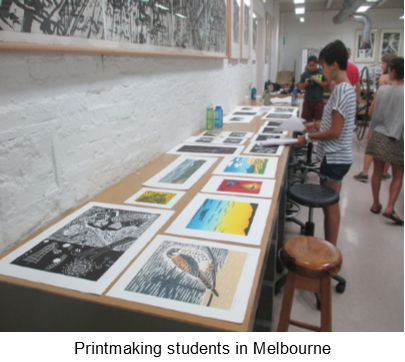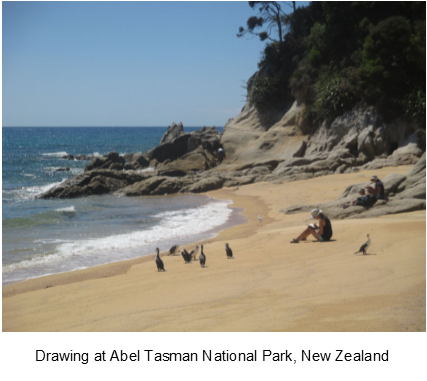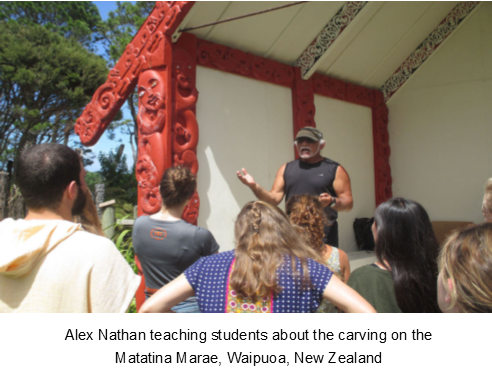Essay: Interdisciplinary Teaching in the South Pacific
By Fred Hagstrom, Carleton College
My introduction to interdisciplinary teaching began with baseball. I watched games with a colleague from the Biology Department at Carleton College, where we both taught. Eventually, my colleague asked me if I would like to lead a program with him in the South Pacific. He taught a program in New Zealand and Australia where students spent most of the term traveling to various national parks. He proposed that we create two groups — he would teach courses in Biology, and I would teach Studio Art — and the two groups would travel together for most of the term. He had experience; I certainly did not, but in 1996 I found myself visiting sites I never anticipated seeing and trying to make the experience a meaningful one for students who were just as new to these surrounding as I was. The first trip did moderately well, but I could see many ways to improve upon it, not the least being that I had to learn more about the ecological, historical, and cultural issues that are so rich in this part of the world.
In the following years I led my own program, separate from the Biology Department. However, my program continued to focus on nature and the importance of an art course grounded in the study of nature. I have now taken 10 groups to the South Pacific, each with about 25 students who study in the Cook Islands, New Zealand and Australia for ten-week terms. Learning about this part of the world has become my most challenging and significant area of professional development. This off campus “classroom” has become my most intense experience teaching outside of my own discipline. Even though I now teach the course alone, I credit my colleague who started me on this track by showing me an example of teaching that goes beyond narrow disciplinary boundaries.
 My program includes three courses: Drawing (from nature), Printmaking, and The Physical and Cultural Environment. The first asks students to draw from nature in sketchbooks that we bind by hand before the trip. I teach bookbinding as a part of this course. The printmaking course takes advantage of studios we can rent in Auckland and Melbourne. Because it is summer there when we visit, we can use dormitories and studios of universities that are not in session. We have a longstanding relationship with the Australian Print Workshop in Melbourne. They offer our students the opportunity to work in their very well equipped studios, and to learn from the printmakers who are associated with their program.
My program includes three courses: Drawing (from nature), Printmaking, and The Physical and Cultural Environment. The first asks students to draw from nature in sketchbooks that we bind by hand before the trip. I teach bookbinding as a part of this course. The printmaking course takes advantage of studios we can rent in Auckland and Melbourne. Because it is summer there when we visit, we can use dormitories and studios of universities that are not in session. We have a longstanding relationship with the Australian Print Workshop in Melbourne. They offer our students the opportunity to work in their very well equipped studios, and to learn from the printmakers who are associated with their program.
The environmental course is what I would call my truly interdisciplinary course; ecology, history, and social issues are our primary subject matter. I knew that there were good studio art programs in Europe, so I felt that if I were to design my own program I wanted it to be unique. Too often students are disconnected from nature, so I knew melding art practice with the study of nature would be fruitful and appropriate for my liberal arts students. I also think that there is more room in our curriculum for the study of indigenous issues, and the histories of Maori, Pacific Islander and aboriginal Australians and their various experiences of colonialism pose potent questions for our study of the region. Students often tell me that learning about the histories of this part of the world has prompted them to examine American history, as well as the current state of affairs for Native Americans, in a different light. I have used several texts for this course. The Future Eaters by Tim Flannery gives a great deal of information on the ecological issues of the region. Pacific Worlds by Matt Matsuda provides an overview of the history of the Pacific. Students learn many new things such as the fact that there was a Pacific slave trade, and that residents of the Pacific are still dealing with the legacy of nuclear testing on their islands. I have also used the seminal article by Lynn White, The Historical Roots of our Ecological Crisis. I have had a number of students on the trip who are environmental studies majors, and they have told me that this trip gives them helpful material for their major.
Maori novels are important to my program, particularly those novels by the writer Patricia Grace. In one instance, an English major on the trip returned to campus and for her senior project studied postcolonial literature, with an emphasis on Maori writers. Patricia Grace was generous enough to meet with this student when we were in New Zealand, and Grace remained in touch with the student as she worked on her senior project. I have also used Come on Shore and We Will Kill and Eat You All by Christina Thompson. This book combines memoir and history to give an insightful view of New Zealand and Maori concerns. Ms. Thompson is very knowledgeable about the South Pacific, and she has given me advice that has helped to shape my program. In Australia I use Jackson’s Track, Memoir of a Dreamtime Place by Daryl Tonkin and Carolyn Landon. This book is about the trouble faced by an inter-racial couple in the 1950’s. The first section explores how two brothers set up a lumber camp east of Melbourne in the late 30’s. They hire aboriginal laborers, and the camp turns into a thriving aboriginal settlement until the early 60’s. The most significant section of the book focuses on the inter-racial couple. Author Carolyn Landon has visited with my students several times, accompanied by her friend, the daughter of the couple from the book.
In the Physical and Cultural Environment course I use local experts to offset my weaker areas. I hire biologists and naturalists to accompany us in each national park and to help explain the particular aspects of that area. Students get to snorkel with a biologist on the Great Barrier Reef, learn about the flora and fauna of an inland park, or trek through a volcanic park in New Zealand. These local experts help me teach and offer assistance as I try to ensure the safety of a large group in a new and remote place. Students and I often stay in bunkhouses or tents, and I have to arrange food for the group; sometimes this is difficult, especially in areas where there is no refrigeration.
I try to impress upon the students that art and nature are closely intertwined and that not all art reflects urban values. They see contemporary artwork from the aboriginal acrylic painting movement, a blossoming form of painting that only began in the 1970’s. I try to make the connection between contemporary art and historical or traditional art. They see historical pieces, functional crafts that date to the pre-colonial period, and contemporary art that is significant on the international scene. They see work by artists who explore environmental themes in contemporary styles. They see Maori and Pacific Islander art that draws upon tradition and comments on contemporary society. We discuss indigenous people’s deep history and examine how they draw upon this history while they remain part of the modern world. It is provocative to think about how one can remain within a tradition and still be open to innovation.
My goal is to give students a deep understanding of that part of the world and to have fun in the process. We go to beautiful parks and sit by beaches, canyons, or streams and engage in extended drawing sessions. After semesters spent making art in campus studios and classrooms, particularly throughout a Minnesota winter, it is refreshing to take a long hike that ends at a large wall of ancient aboriginal rock art, or to listen to the surf as we draw. I make the point that nature is the source of much indigenous art, and that nature can be fundamental to design in a western context. Our campuses are often too busy to allow for long periods of contemplation, and the process of slowing down to observe carefully from nature can be a powerful learning experience for our students. I hope students leave the program with an enhanced interest in the natural world, and a certainty that they can see nature as an avenue for artistic expression.
Off-campus study should be experiential, so I try to immerse the students in environments that are stark contrasts to their homes. I let them see that indigenous art is often intricate and takes extraordinary care and craft. This is true of contemporary work as well as historical examples. I urge students not to view the art as an ethnographic experience and instead to see it as vibrant and relevant in 2015. They understood this one day when we were on Cook Islands, where the local women who are fine artists display their fiber work (called tivavae) and teach the students how this work is done. The women’s imagery depicts the beauty of the nature that surrounds them on their small island of Rarotonga. Celebrating their connection with nature is a crucial part of the artists’ spiritual lives.
A highlight of the program is a three-day stay at a marae, a traditional meetinghouse for a Maori tribe. We have a long relationship with this community, and they open their homes and their hearts to us. The students get an introduction to Maori life and culture that can’t be taught, that must be experienced. I take students to museums to see Maori art, and I assign readings and lectures that cover both historical and contemporary art. But at the marae the students learn about deeper cultural values as well as what it is like to be Maori in contemporary New Zealand. An important lesson comes when the elders of the marae describe the ancestral carvings that cover the meetinghouse, explaining the importance of genealogy (whakapaka) and how each of the carvings refers to specific histories of their tribe.
When we study the terrible history of aboriginal Australians, I am able to find texts, speakers, and films that help students understand this long, sad story. We use a text, Aboriginal Australians by Richard Broome, and a documentary series, The First Australians that give the students a good introduction to aboriginal culture and history. Richard Broome has also lectured to the students in Melbourne. In an off-campus experience it can be difficult to teach the students about material that includes such a sad and violent history. They are excited to be in such a different part of the world, but they should also know the full history of the region.
The logistics of the program are complex, but we have been able to work everything out. We make reservations with the parks to secure bunkhouses that can accommodate our group. I hire caterers to provide food in these remote locations.
I take two recent graduates of a previous trip to help me manage the group. The students receive one full term of credit. My school is on a three-term schedule, and students take three courses per term. I normally teach two courses, so the trip is an overload for me. I could hire local people to teach one of the courses, but our schedule includes so much travel that this is difficult. Tuition covers the total cost for students, including all art supplies and textbooks, but they do have to pay for their flights. I negotiate a group rate with the airlines to reduce their cost, but with this much travel, students still pay over $2,000 for our international travel.
Faculty development can be an unrecognized benefit of teaching in an off campus setting. Because I have returned there over many years and have devoted considerable time and study to learning about the region and the culture, the South Pacific has become a major part of my research. When a department offers a trip taught by various professors over a number of years, these faculty miss out on the advantages of prolonged contact with a community abroad. I know that I am a different artist and teacher than I would have been without this experience. I am different not only because of the experience of being abroad, but also because I have to combine and integrate different disciplines; this has deepened what I think I can offer to my students.
I would never have anticipated that as a teacher I would tell students about the gestation cycle of a kangaroo, let alone travel alongside one or swim over a manta ray. I also never anticipated I would have a place that I can call a second home in a remote part of New Zealand and with my Maori friends. Each of these experiences has pushed me to learn more and to sharpen my teaching skills. I do not want to teach a superficial course in these areas, and as anyone who teaches outside of his area of expertise would tell you, we have to avoid dilettantism. But integrated learning can be a powerful experience for students, and in order for us to open these doors to them, we must be willing to move into new ground.
